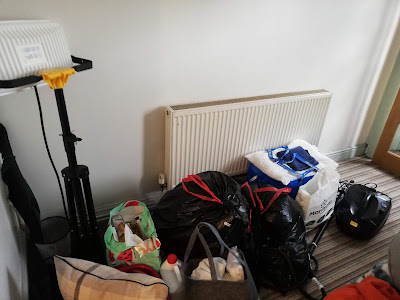In these times of Covid-19, we now use the ultraviolet-c lamp in the process of cleaning. We first suit-up in full body PPE equipment, including a respirator, prior to entering the cottage. As part of the procedure we assume the departing guests could have been infected asymptomatically with the virus. We then progress around the rooms in the cottage giving a timed exposure to each room from the Ultraviolet-C light to help sterilize the environment.
Saturday 26 September 2020
Ultraviolet lamp in operation, cleaning self-catering cottage
Friday 18 September 2020
Using video processing for the Self Catering Holiday Cottage.
We been using digital video cameras for some time in our other businesses in the production of training videos. To aid that process we use Cyberlink's video editing software called PowerDirector. We then host the video on vimeo.com. This allows advert free content which can be reliably streamed to multiple devices across the Internet.
In the new Covid-19 cleaning regime for our holiday cottage, we now produce a complete video of the cottage interior after every turnaround cleaning session between guests. We use a GoPro Hero 5 for quick and fuss free filming. When we get home it only takes 20 minutes to produce the video and upload it to vimeo.com. This video output has proved extremely helpful and cost effective in resolving any post visit guest queries. We've found recently that Covid-19 staycation guests' expectations can exceed the norm, and they look to reduce costs by threatening to post unrealistic visit comments. This change of guest behaviour often feature in comments in the cottage owners Facebook group.
One of the features of the Cyberlink PowerDirector is the ability to easily apply preset Colour Lookup Tables (LUTs) to individual video clips. These can significantly improve the quality of the output to get a more lifelike rendering on the video. The contemporaneous video of the cottage also supplements the inventory list of the cottage contents.
Saturday 12 September 2020
Newly painted cottage, paintwork damaged after just two lettings
12th Sept 2020
When we cleaned the cottage at the last changeover, my wife noticed that the wall surface in the bedroom had been scuffed leaving dark marks on the newly painted wall. Presumably this had been caused by a carelessly handled luggage scraping against the wall.
Saturday 5 September 2020
Cottage Cleaning in a Covid-19 era
We've just finished cleaning the cottage after our first guests after we re-opened the cottage to rental in the Covid-19 era. A one bedroom cottage, the two guests stayed for three nights. Cleaning time was three hours, including steam and Ultraviolet-C sterilisation. On top of this was an additional 30 minutes documentation time. It created a mound of items for transport to/from the cottage.
We note that the guests neglected to fill in the Track and Trace forms, we'd left for them, giving their contact details. Whilst we can follow up via the Sykes Agency, it adds delay and complexity to the tracking process. There's no way they could have missed the forms because we'd placed the WiFi password at the top of the contact forms.
Edit 26th Sept 2020: For each cleaning session, we now produce checklists and video the results. This information can be accessed here: 💭
Thursday 3 September 2020
Rotating Guest Consumables in our holiday cottage - Covid-19
As part of the guest supplies for our holiday cottage we provide items such as hand soap, paper kitchen towels, washing up liquid, cooking foil, tissues, clingfilm (saran wrap), disinfectant, washing machine powder, ground pepper, salt. With the exception of hand soap, most of that is only partially used in a typical week long stay. We retain these supplies for the next guest, and normally replace them when the consumable has been fully used up or expired. It keeps down costs to the guest, but also saves them from the need to bring such items or to purchase for the duration of their holiday.
However in these times of Covid-19 Virus we cannot follow those practices. We have to remove any items which may have been touched by an infected guest but are not possible to safely disinfect. This could include paper goods or other items with a sensitive wrapping. The virus can remain live on the surface of some items for up to a week. While we could use Ultraviolet-C light it would require careful manipulation of the item to ensure a full disinfection exposure.
We have chosen to rotate items from the cottage during the cleaning process. They'll be replaced by identical items that have been stored for at least 10 days during which time an surface virus should have degraded. So we're marking each item with a Rota Label; Rota A, Rota B, Rota C. During each cleaning process we'll replace the previous Rota with the next in the series. We've been busy making up cleaning boxes containing all the necessary items. Each item os labelled according to its rota. It does mean we've had to purchase several times the usual amount of consumables, but it will increase the safety for our guests.




